Tips for family travel & camping with a baby
Signing up for credit cards through partner links earns us a commission. Terms apply to the offers listed on this page. Here’s our full advertising policy: How we make money.
Update: One or more card offers in this post are no longer available. Check our Hot Deals for the latest offers.
Planning a family trip or taking your baby camping for the first time? It can be a daunting proposition, but I can (almost) guarantee it will be well worth your effort and time. As a mom who’s traveled fairly extensively with my daughter, I’ve learned a few things along with way.
When my daughter was less than a year old, I decided to take a road trip to fantastic National Parks like Yosemite, Death Valley, Red Rock Canyon, Zion, and Bryce Canyon. It was a perfect time to do so because my daughter was still light enough to carry in a backpack.
I’ll share with you the tricks I’ve learned from traveling with a baby. Plus, if you’re new to the miles & points hobby, I’ve included links to other posts that are especially helpful to families!

Where to go camping with a baby
For the most part, any spot you might pick to camp without kids is probably suitable for camping with kids, too. Look into state parks, national parks and private campgrounds, all of which can offer amenities and great locations to pitch a tent. When narrowing down your options, here are some things to consider:
Choose your destination carefully
This concept has been important for me to learn since having a baby because I’ve always been used to just picking any ol’ spot, packing up, and going. And most of the time, I chose destinations based on what types of activities they had to offer, like diving, biking, hiking, etc.
But with a baby, you have to shift your priorities. So choosing the “right” destination becomes more important.
For example, if you have a four-year-old, they’re likely too heavy to carry in a backpack for hours on end (and don’t want to be still for that long). So taking a hiking vacation might not make sense.
But heading to a new city and visiting museums, the zoo, or aquarium, could be an excellent plan.
Limit driving time
The main goal of a camping trip is to relax and get away, so don’t stress yourself out by making the journey more complicated than it has to be. One way to keep things simple is to eliminate the stress of a long car trip by staying close to home. In limiting your driving time, you won’t have to get up insanely early to make it to your destination. And, if things go wrong, it’s easy enough to get home.
Choose a campsite with amenities
This tip is especially important if this is your first camping trip with a baby or if you aren’t a seasoned outdoorsman or woman. Choosing a camping spot with certain amenities, like bathrooms and potable water, can help you avoid unnecessary stress. Once you’re comfortable, you can head out to more remote destinations.
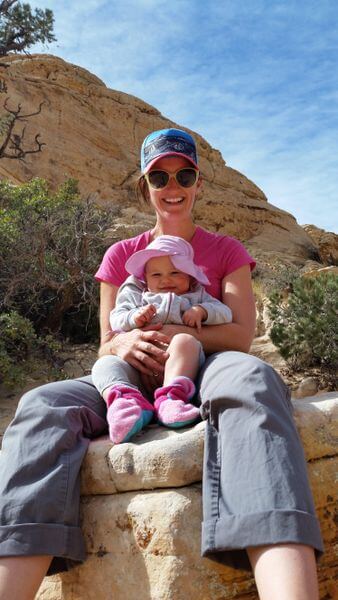
Choose a more secluded spot
If you’re nervous about your screaming baby waking up the entire campground, do yourself a favor and choose a spot as far away from everyone else as possible. You’ll sleep better just knowing there’s a little distance between you and your neighbors.
Choose a shaded site
Choosing a shady camping spot (as opposed to one in the sun) can make a world of difference when it comes to your family’s comfort. If possible, find a site that offers a bit of protection from the sun — maybe one next to a large tree. Not only will you be protecting your baby from UV rays, but your tent will be cooler throughout the day.
Tips for sleeping in a tent with a baby
It’s hard to sleep with a baby regardless of where you are — at home, in a hotel, in a tent, etc. So here are a few things to consider when you’re venturing out on your first camping trip:
Get a big tent
Having been a backpacker and mountaineer in a previous life (read: before baby), I’ve always been a minimalist packer. The smaller and lighter, the better. But when it comes to family camping, the bigger, the better! A large tent will give you the extra space to spread out and get comfortable. And it will provide you with room for a portable crib if you decide to bring one.
Practice
If you’re camping with your kid(s) for the first time, it’s a good idea to take your tent for a test run. I put the tent up in my living room and let my daughter play in it for a few days, so she wouldn’t be freaked out about it once we started traveling.
Bring a portable crib or play yard
If your child is used to sleeping in a portable crib, this can be an especially good idea. A crib or play yard can also come in handy if you need to contain your cute little monster while you get things done around camp.
If I’m bringing along a portable crib, it’s usually the first thing I set up. That way, I can have both hands available when setting up camp or cooking a meal.
Bring a few comforts from home
From my experience, babies and kids find comfort in routine. When you’re traveling, keeping a routine is more difficult. But bringing a few comforts from home can make the transition easier.
For Em, her bear is of utmost importance. I also brought along a blanket she uses a lot at home. If your kids are old enough, you could ask them what special item they’d like to bring along!
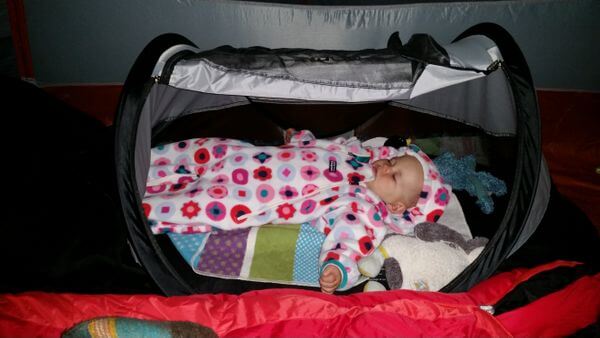
Meal planning for a baby
Prioritize convenience
This tip is relevant to meal planning, whether you’re camping with a baby or not. I wouldn’t recommend trying to pull off a chef-style meal at the campsite, especially if this is one of your forays into the wild. Keeping things simple will ensure you have a less stressful cooking experience.
When it comes to choosing foods for kids, if your child is eating solids, take along squeeze packets and dried cereal. Avocados and beans are other fantastic options as both are portable and easy to eat, either with a spoon or as finger food.
Even better, if you can, plan the adult meals around the foods you’re bringing along for your child. For example, avocados go great with eggs and beans can be the perfect base for a soup.
Remember to sanitize
Don’t forget about the need to sanitize any items you’re using to feed your baby, like spoons and bottles. You probably wouldn’t give this a second thought at home, but at camp, you’ll need to have a way to boil water to sanitize utensils. And if you need to mix formula, you’ll have to make sure you have access to potable water.
Tips for dressing your baby for camping
Pack light
Even without a baby, I’ve always been a proponent of packing as little as possible. It makes everything easier! There’s no hauling multiple bags through the airport or searching through piles of clothes to find something.
Simplicity is key and will make your job of keeping your kid (or kids!) safe while traveling that much easier. So take the time to prepare and figure out the items that are necessities and those that are just nice to have.
The more you venture out, the better you’ll be at deciding what you actually need.
Dress in layers
Dress your kid(s) in the same way you’d dress yourself for a day in the outdoors. Layers are best to adapt to changing weather — a base layer, mid-layer, and outer layer. The base layer is meant to regulate your body temperature (wool is excellent for this layer). The middle layer provides added warmth. And the outer layer is there to protect you from weather like wind and rain.
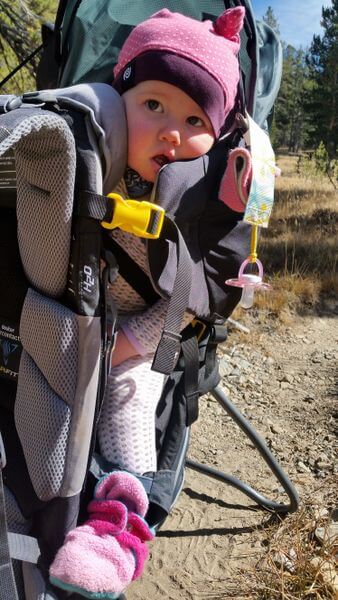
Choose the right fabrics
If you anticipate running into any sort of variable weather during your trip, be careful about the clothing you pack. There are fabrics that are meant to perform — and those that aren’t. For example, synthetics and wool do a better job of insulating and dry more quickly than cotton. For sun protection, consider breathable long-sleeve shirts that’ll provide protection but won’t cause you or your child to overheat.
Ways to save money on a family vacation
Camping, hotels, & Airbnb stays
If you decide to camp during your vacation, be sure to bring enough cash because you can not pay with a credit card at a lot of campsites, unless you’re booking your site in advance.
And if you want to use points for a hotel stay, you can use tools like Hotel Hustle and AwardMapper to help search for award nights along your route.
Just remember, it can be hard to find chain hotels inside most parks. So you’ll have to decide whether it’s worth staying outside the park and driving in each morning. Or you could even find a great Airbnb nearby!
I like spending as much time exploring as I can during a vacation, so I’d prefer to pay cash for a hotel inside the park to save time and save my points for another trip.
Gas
One of the most significant expenses on a road trip is gas. So use a credit card that earns miles, points, or cash back at gas stations.
I used my Chase Ink Plus (no longer available) that earns 2X Chase Ultimate Rewards on gas. But you could also consider a card like the Blue Cash Preferred® Card from American Express that earns 3% cash back at U.S. gas stations. Cash back is received in the form of Reward Dollars that can be redeemed for statement credits.
Check out our guide to the best credit cards for gasoline purchases.
Flights & rental cars
Depending on where you live and which parks you plan to visit, you might need to fly closer to your destination and rent a car. Using the Southwest Companion Pass can save you lots of money on airfare because you can fly nearly 2-for-1 on domestic paid and award tickets.
Pay with a credit card that earns bonus miles and points on airlines. Or a card that earns a bonus on travel, like the Chase Sapphire Preferred® Card.
And if you need to rent a car, read this guide to finding cheap car rentals, for tips & tricks on saving money on rental cars.
More ways to save money
All of the National Parks charge a vehicle entrance fee, so depending on how many parks you plan to visit, it could be worth buying an Annual Pass that costs $80.
I did the math, and if you plan on visiting 2+ parks over the year, an annual pass is likely worth it. Because the major parks, like Yosemite and Grand Canyon National Park, charge $30 for a week-long permit. And the pass grants you access to other National Park Service monuments, like Devils Postpile, that can easily cost $10+ per visit.
Tip: This Wikipedia page lists the areas in the U.S. National Park System, so it’s a useful resource for planning your trip.
Plus, if you need to buy gear for your trip, you can go through shopping portals that earn cash back, miles, or points at certain retailers. I like using sites like CashbackMonitor.com that show you what bonuses various portals are offering.
And don’t forget to check out this post on how to plan a terrific road trip!
Bottom line
Just go! The timing will never be “just right,” and nothing will ever go exactly as planned (even without a kid), so my best piece of advice is just to go. Because life goes fast and you need to pack in as much fun as you can!
Plus, the more you get out, the easier it becomes. Our first trip outside the U.S. when Em was ~3 months old calmed many of my fears as a new mom. You can’t expect to see as much or do as much as when you traveled without kids (believe me!). But as cliche as it sounds, it really IS cool to experience things through their eyes. So go slow, take breaks, and enjoy yourselves. And don’t forget to take a lot of pictures!
Do you have any tips or tricks for camping or traveling with a baby? Share them in the comments!
All photos are by the author.
Editorial Note: We're the Million Mile Secrets team. And we're proud of our content, opinions and analysis, and of our reader's comments. These haven’t been reviewed, approved or endorsed by any of the airlines, hotels, or credit card issuers which we often write about. And that’s just how we like it! :)
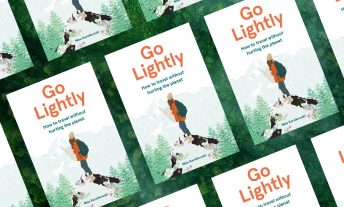
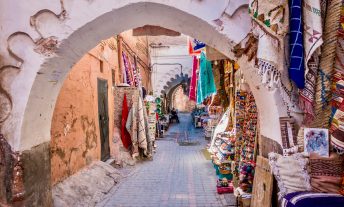




Join the Discussion!